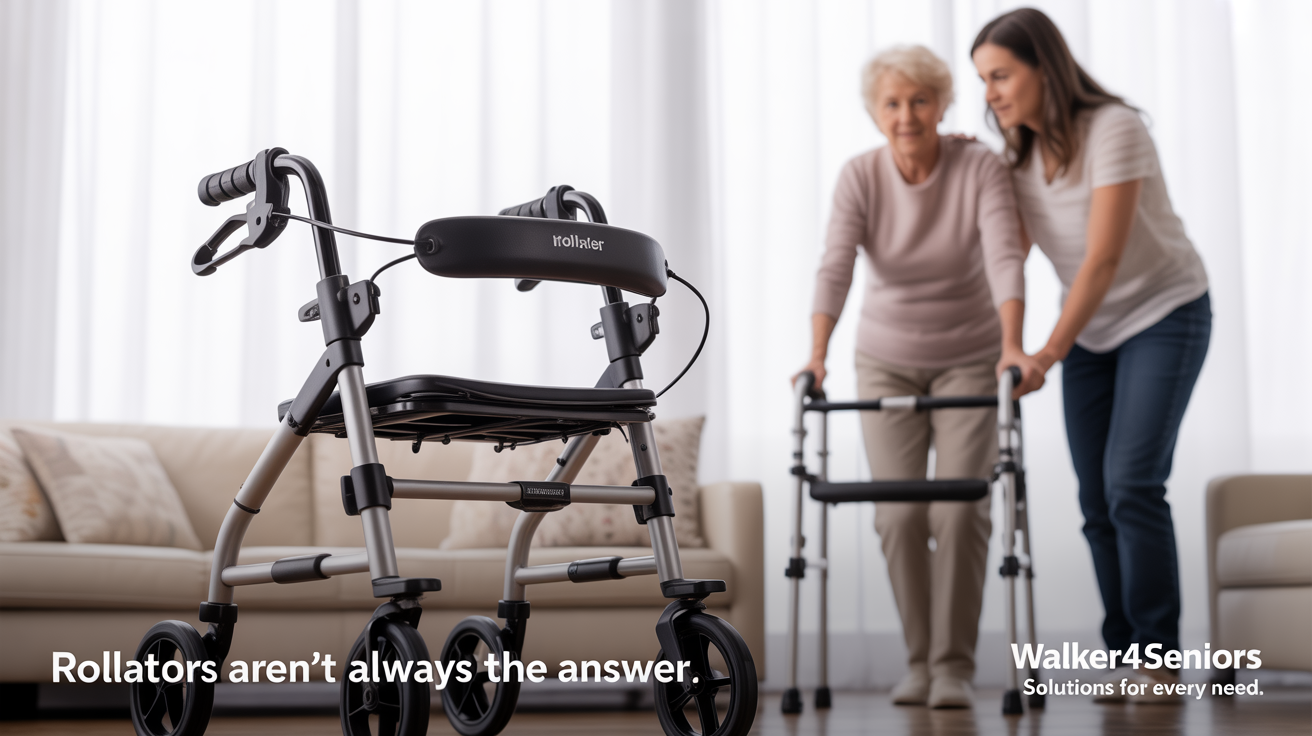When most people picture a walker, they see a simple aluminum frame—a basic tool for getting around. But this view misses the critical, often counter-intuitive details that can dramatically impact a person’s safety, comfort, and independence. Choosing and using a walker is far more complex than it appears. This article will reveal five of the most surprising and impactful truths about walkers, based on expert reviews and user experiences.
——————————————————————————–
1. A $750 Walker Isn’t Always Better Than a $50 One
It’s natural to assume that a higher price tag means a better product, but in the world of assistive technology, this is a dangerous oversimplification. To understand this, consider a direct comparison between three popular models at vastly different price points, which reveals that the “best” walker is defined by its performance in a specific environment, not its cost.
In a hands-on test, the humble $50 Drive Basic walker, with its narrow 21-inch width, was the undisputed winner for indoor use, effortlessly navigating the tight corridors and small bathrooms that are common in many homes.
Meanwhile, the mid-range $200 Drive Nitro excelled outdoors. Its large 10-inch front wheels, which were “fantastic in the grass” and ideal for navigating curbs with its “curb assist” feature, proved cumbersome indoors, struggling to make tight turns where the cheaper model excelled.
Finally, the premium $750 Nuvio1 showcased its value with a unique frame that allows a user to stand inside it. This design offered unparalleled stability, especially when backing out of a confined space—a common challenge where other walkers leave the user feeling exposed and unstable.
The analysis is clear: a higher price buys specialized features, not across-the-board superiority. The right choice requires matching a walker’s specific design trade-offs to the user’s daily life, proving that the most expensive option can be the wrong one.
——————————————————————————–
2. “Walker” and “Rollator” Are Not the Same Thing—And the Difference is Critical
While the terms are often used interchangeably in casual conversation, a standard walker and a rollator are fundamentally different tools designed for different needs. From a safety standpoint, this distinction is non-negotiable.
- Standard Walker: This device, which has no wheels or only two on the front, is engineered for maximum stability. It is designed for users who must bear a significant amount of their weight on the frame. Because it must be picked up and placed with each step, it is suited for individuals who are very unstable, may not be able to control a rolling device, or are living with conditions like bilateral lower-extremity disease.
- Rollator (Four-Wheeled Walker): A rollator features four fully rotating wheels, hand brakes, and typically a built-in seat. It is the ideal choice for users who need a device for balance support and to improve endurance, but not for significant weight-bearing.
Confusing the two can be dangerous. Using a rollator to support your full body weight—a task it was never designed for—can cause it to roll out from underneath you, leading to severe instability and a high risk of falling.
——————————————————————————–
3. There’s a Right Way to Set the Height, and It’s Not Guesswork
The single most important adjustment for any walker is its height, and there is a clinical standard recommended by physiotherapists to ensure safety, proper posture, and optimal support. Guesswork is not an option.
The correct method is precise and simple:
- Stand upright in your normal walking shoes with the best posture you can achieve.
- Allow your arms to hang in a relaxed, natural state at your sides.
- The walker’s hand grips should be adjusted to be perfectly level with the crease of your wrist.
When your hands are placed on the grips, this alignment should create a comfortable elbow bend of approximately 15 degrees. Setting the height incorrectly, even by an inch or two, introduces significant risks.
- Too Low: A walker set too low forces the user to hunch over. This poor posture puts damaging strain on the back, neck, and shoulder muscles, which can lead to chronic pain.
- Too High: A walker set too high forces the user to shrug their shoulders and bend their elbows excessively. This stresses the shoulder and neck, compromises balance, and can cause arm fatigue that makes the walker unsafe to operate.
——————————————————————————–
4. Advanced Walkers Solve Problems You’ve Never Even Thought Of
Beyond simple frames for balance, the next generation of walkers are engineered to solve highly specific and often debilitating challenges. These devices are no longer just mobility aids; they are targeted therapeutic tools.
Two examples illustrate this evolution from passive support to active problem-solving:
- Sit-to-Stand Support: The Nuvio1 walker is designed to double as a stand-support frame. After flipping the seat up, the user can position the walker in front of a couch or chair and use dedicated pegs on the back of the frame to push up from a seated position. This provides a stable, supportive frame precisely when and where it is needed most during a difficult transfer.
- Overcoming Neurological “Freezing”: The U-Step walker is engineered specifically for individuals with neurological conditions like Parkinson’s disease. It features a “reverse braking system,” where the walker is locked by default and only moves when the user squeezes a brake handle, preventing it from running away from the user. For those who experience “freezing of gait”—a debilitating symptom where one’s feet feel glued to the floor—an optional laser projects a red line on the ground, providing a crucial visual cue to help break the freeze and initiate a step.
As one user powerfully described its impact:
“As a parkinsons patient I have FOG (freezing of gait). I can be walking and for no apparent reason my legs stop working… A physical therapist found that I reacted to visual signals… That led to the U-step II with the laser line. It worked so well for me that I now have 2… It has made a real difference in my mobility.”
——————————————————————————–
5. Your Rollator Can Be a Serious Fall Risk
Counter-intuitively, a device designed to prevent falls can become a significant hazard if its inherent risks are not understood and respected. Rollators, in particular, present two specific dangers that every user must be aware of to stay safe.
The Hidden Danger of the Seat A rollator’s seat is an excellent feature for rest, but it can be dangerously misleading. Users should always park the rollator with its back against a wall or other immovable object before sitting. Even with the brakes fully locked, the force of a person sitting down can be enough to push the rollator out from underneath them, resulting in a serious backward fall onto a hard surface.
The Instability of Three-Wheeled Designs Three-wheeled walkers are often described as “zippy” and praised for their maneuverability in tight quarters. However, this agility comes at the cost of stability. Their triangular, narrow base of support makes them inherently more prone to tipping over, especially when making a turn. This risk is amplified for taller users, whose higher center of gravity can easily destabilize the narrow frame during a turn.
——————————————————————————–
Conclusion
Ultimately, a walker is not a commodity but a sophisticated piece of medical equipment. Moving beyond price and appearance to understand the interplay between your environment, your specific needs, and a device’s features—whether it’s the frame width for a narrow hall or a laser line for a neurological symptom—is what transforms a simple frame into a life-changing tool. Now that you know a walker is more than just a frame, what’s the one question you’ll be sure to ask before choosing one for yourself or a loved one?

